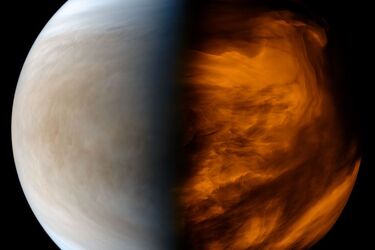Scientists officially confirm the presence of oxygen in the daytime atmosphere of Venus

Observations of the Venusian atmosphere have revealed the presence of atomic oxygen in the daytime, floating above its toxic clouds. This discovery is important because the daytime detection of atomic oxygen over Venus points to new aspects of its atmospheric dynamics and circulation patterns. The results of the study were published by a team of physicists led by Heinz-Wilhelm Hubers from the German Aerospace Center (DLR).
While Venus is similar to Earth in mass and composition, it differs in many other ways. Venus is completely different from Earth: its atmosphere is filled with toxic and dense clouds composed mainly of carbon dioxide. It also creates a powerful greenhouse effect that maintains an average surface temperature of approximately 464 degrees Celsius (867 Fahrenheit). This was reported by Science Alert.
Read also: Scientists have invented a way to fly to Mars in just 45 days instead of a year
Acid rain also falls there, and its entire atmospheric turnover occurs very quickly. Winds on Venus, especially above the clouds, can reach speeds of about 700 kilometers per hour. For comparison, the fastest wind on Earth was recorded at 407 kilometers per hour in a hurricane.
The comparison of the properties of Venus and Earth remains mysterious, and the study of Venus' atmosphere will help to reveal their differences. The detection of atomic oxygen during the daytime on Venus indicates a new resource for studying the transition zone of this planet's atmosphere.
Atomic oxygen is different from the molecular oxygen we breathe on Earth. The latter is composed of two bonded oxygen atoms (O2), while atomic oxygen is composed of individual oxygen atoms and is not stored for a long time because it easily reacts with other atoms. On Earth, atomic oxygen is formed at high altitudes as a result of the photodissociation of molecular oxygen.
A similar process is likely to occur on Venus, where atomic oxygen is produced by the photodissociation of carbon dioxide molecules under the influence of solar radiation. The oxygen atoms recombine on the night side of Venus, causing this part of the planet to glow. Prior to this study, atomic oxygen had been detected on Venus at night, but its daytime detection reveals a new aspect of its atmospheric dynamics.
The researchers used data collected by the Stratospheric Observatory for Infrared Astronomy (SOFIA), flying high in Earth's atmosphere and collecting information on 17 points on Venus. They detected atomic oxygen at all 17 points, with the main peak in concentration observed at an altitude of about 100 kilometers. This is an important result because this altitude is located between the two dominant atmospheric circulation models on Venus.
The discovery of atomic oxygen during the daytime on Venus opens up new opportunities for further research on this mysterious planet and contributes to future space missions to Venus. These data, together with measurements of atomic oxygen in the atmospheres of Earth and Mars, will help improve understanding of why the atmospheres of Venus and Earth are so different from each other.
Earlier, NASA showed a picture of mysterious deposits in Martian craters, which was taken by the HiRise instrument of the Mars Reconnaissance Orbiter spacecraft. Earlier, NASA also showed a photo of sunlight on Mars breaking through the clouds.
If you want to get the latest news about the war and events in Ukraine, subscribe to our Telegram channel!
